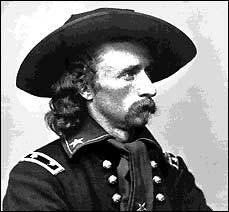|
|
|
| Born in New Rumley , Ohio, Custer lead a simple
life. After high school , however, He decided to change that. He went to
West Point, unfortunately he failed any chances at recognizable achievements.
Seven days after graduating he failed to do his duty as a member of the
guard to stop a fight. He was court-marshaled , but the need for
Civil War officers saved him from expulsion. Custer did well in the war. He served in the battles of
Bull Run (the first one ), Virginia, and Gettysburg. Though he lost many
men, even by the war's standards, his determination earned him the respect of the other generals and
the public as well. His forces played a crucial part in the defeat of
the south at Appomattox. Gen. Grant gave him the Appomattox surrender
table as a reward.
In the July of 1866, Custer became the lieutenant- coronal of the 7th cavalry. In 1867 he helped lead a campaign against the Cheyenne with his men. Late into the year Custer was court-marshaled (again!!) and suspended for 1 year for being absent from his command. Custer believed that he was the scapegoat for a bad campaign. Gen. Philip Sheridan agreed , reactivating Custer in 1868. Custer redeemed himself by the attack on Black Kettle's tribe on the Wichita river. In 1873 he was sent to the Northern Plains. There he engaged the Lakota in small battles. The following year he and 1,200 other men, went to claim the Black Hills. These , consequently, had been promised to the Lakota 6 yrs. earlier. Custer was to lead an anti-Lakota expedition with Gen. John Gibbon and Gen. George Crook. He almost missed this because of his testament to Indian Services corruption, Grant was furious and relieved him of command and he was replaced by Gen. Alfred Tory. Public disgust with this decision ,however , caused Grant to reverse his decision. Custer headed West. The first U.S. plan to beat the Lakota required 3 forces ,under the control of Crook, Gibbon, & Custer, to trap the main force of Indians in-between them and defeat them. Custer came across a large village (boy was he in for a surprise) on June 25, 1876. His advance had put him far ahead of the other units one of which had been turned back by Crazy Horse. Custer ordered an attack on the village. underestimating the Indians prowess Custer split his force into 3 groups. The attack was a disaster. Thousands of Indians forced them back, surrounded them and kill everyone of them. Though his mistake proved fatal, Custer's fame was unparalleled. His wife wrote books on him. She described him as a smart, well-mannered gentleman, and a politician. Many paintings of Custer's Last Stand have been produced. In many he was depicted almost as a martyr. The fact he started the fight faded into irrelevancy. Facts you may not know Custer served in the 5th cavalry He was a staff officer and courier during the Civil War Just before Gettysburg he was promoted to Brigadier Gen. in the Volunteers He was in most C.W. cavalry movements in the C.W. He was buried at west point -Section 27, Row A, Grave 1 On his honeymoon he received telegrams to come back to the 7th He left his wife for the telegrams Elizabeth Custer was the only wife to follow the 7th around Custer had an Indian child Custer lived in the 8th division barracks at West Point Custer was often kept awake by chickens while at West Point Once in Dakota his train was snowed in After he died his were ears cut by Indians so he would hear better in the afterlife The tips of his pinkies were cut off as well He was a member of the guard at West Point His brother died with him He was called "Long Hair" by the Indians His brothers called him "Audie" He was a Major Gen. in the Volunteers He was a Brevet Major in the regular Army He was considered a "victim" of the Indians
|
|
